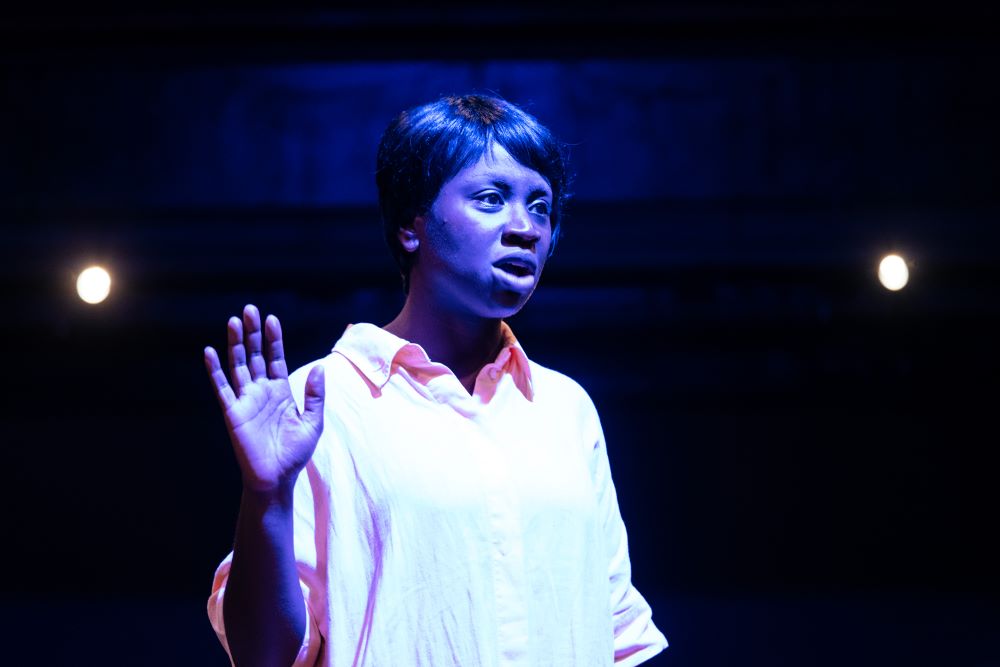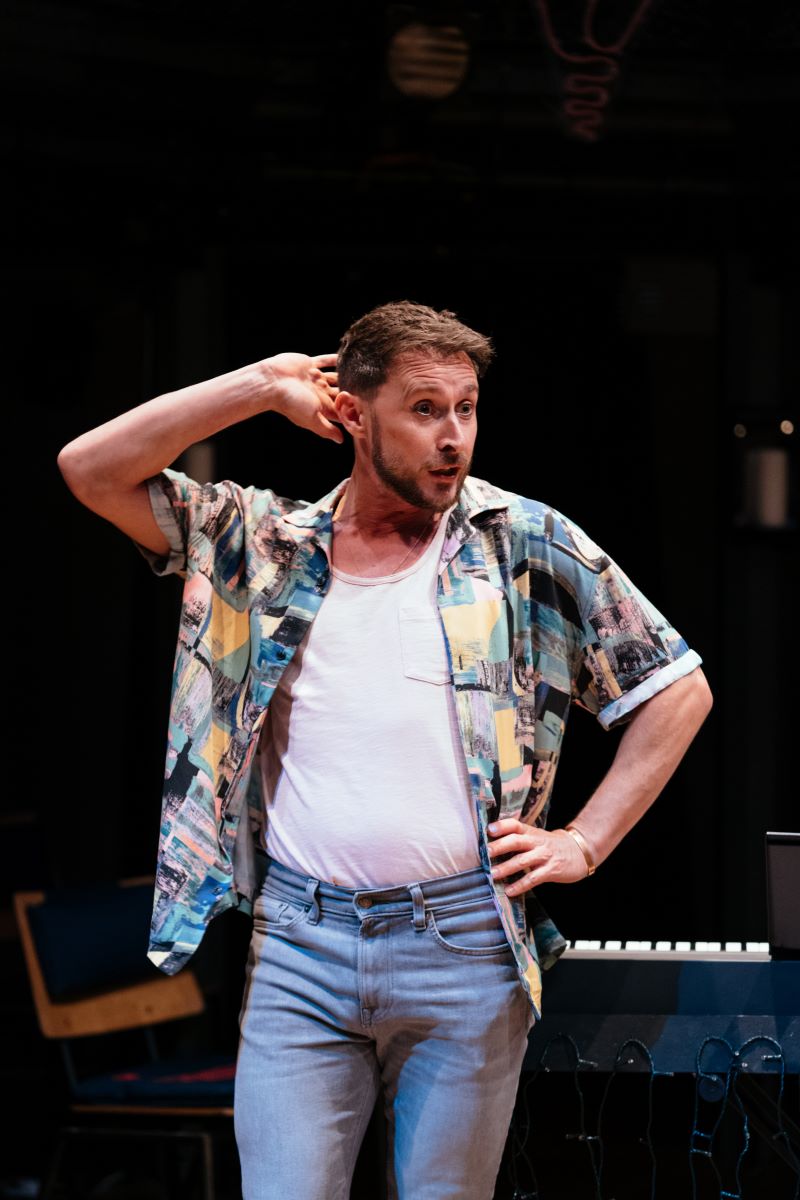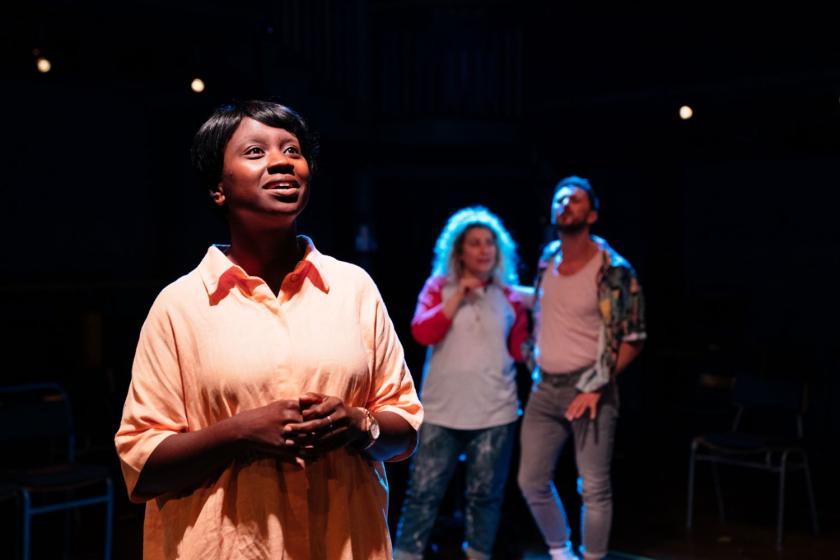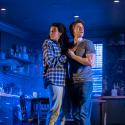Last Easter has become a lot more relatable since it was forced to postpone this run at the Orange Tree Theatre, originally scheduled for 2020. It’s about a group of theatre-makers – an actor, a drag performer, a prop-maker, and a lighting designer – getting through tough times by leaning on each other, but Bryony Lavery wrote it in 2004, way before the lockdowns and the theatre closures and the months of Zoom productions. Now that it’s made it to the stage, Tinuke Craig’s production is timely, if strangely off-putting.
June (Naana Agyei-Ampadu, pictured below) is dying of breast cancer, and she’s trying to figure out how to deal with that. Her friends Leah (Jodie Jacobs), Joy (Ellie Piercy), and Gash (Peter Caulfield) have an idea: a trip to Lourdes, city of Catholic miracles, where a medieval peasant girl saw a vision of the Virgin Mary 18 times. No matter that only one of them is Catholic. Somewhat predictably, the only thing that June likes about religion is the lighting, but she lets herself be dragged along anyway. “This isn’t some big tragedy,” she tries to insist. “Yeah, right!” chorus her pals. Gash pokes fun at June for seeing herself as a sun and her friends as “dim bulbs”, but Agyei-Ampadu’s performance is so strong it brings everyone into her orbit. It’s her show – and also the real-life lighting designer’s. Elliot Griggs’ beautiful states echo the interplay of blue moonlight and orange lamplight in Caravaggio’s The Taking of Christ, described lovingly by June.
Gash pokes fun at June for seeing herself as a sun and her friends as “dim bulbs”, but Agyei-Ampadu’s performance is so strong it brings everyone into her orbit. It’s her show – and also the real-life lighting designer’s. Elliot Griggs’ beautiful states echo the interplay of blue moonlight and orange lamplight in Caravaggio’s The Taking of Christ, described lovingly by June.
The Orange Tree has a lovely sense of community. The staff are cheery, and the seats could’ve come from any rehearsal room in London (outfitted with a little more cushioning, thankfully). Hannah Wolfe and Natalie Johnson’s set is touchingly bare except for a keyboard and four chairs with wheels, upon which the cast zoom around (literally) to great effect. It’s odd that the venue’s warm welcome is so absent onstage.
The trouble is that Last Easter is about Theatre People, who, ironically, do not make good theatre subjects. Even if we leave aside the navel-gazing aspect of actors playing actors and playwrights writing plays about plays, it’s just irritating. Scenes in the first half are like hanging out with a group of friends who have far too many in-jokes, and far too much interest in performing them for you at every opportunity. Great for Judy Garland fans; not so much if, like me, you struggle to name any hits beyond "Over the Rainbow". Craig hasn’t quite sorted her blocking out – it’s tricky to treat all sides roughly equally when you’re in the round, but large swathes of the show were just inaccessible from where I was sitting, adding to that alienating sensation.
 Jacobs comes into her own in the second half, showing us Leah’s practical side warring with her love and worry for June. Piercy tries her best with Joy, the most off-putting character. She spends a lot of the play drunk, and drunk people just aren’t that interesting to anybody else. They’re inherently self-centred, and Joy more so than most, what with her obsession with an ex-boyfriend who committed suicide and is apparently haunting her. Caulfield (pictured left) has boundless energy, and is a brilliant pianist, meandering over to the keyboard and plucking tunes seemingly out of thin air. Last Easter comes closest to being a great play in these moments: when the intensely performative aspect drops away, and it’s just four friends dealing with death together.
Jacobs comes into her own in the second half, showing us Leah’s practical side warring with her love and worry for June. Piercy tries her best with Joy, the most off-putting character. She spends a lot of the play drunk, and drunk people just aren’t that interesting to anybody else. They’re inherently self-centred, and Joy more so than most, what with her obsession with an ex-boyfriend who committed suicide and is apparently haunting her. Caulfield (pictured left) has boundless energy, and is a brilliant pianist, meandering over to the keyboard and plucking tunes seemingly out of thin air. Last Easter comes closest to being a great play in these moments: when the intensely performative aspect drops away, and it’s just four friends dealing with death together.
Craig and the cast nail it in the final scene, but it’s too little, too late. Griggs’ lighting, here as throughout the show, is gorgeous: the stars are twinkling overhead; there are fairy lights hiding in jungle vines; the eyes of a treefrog puppet Leah constructed for a children’s show are picked out in warm orange. It’s what June would have wanted.















Add comment